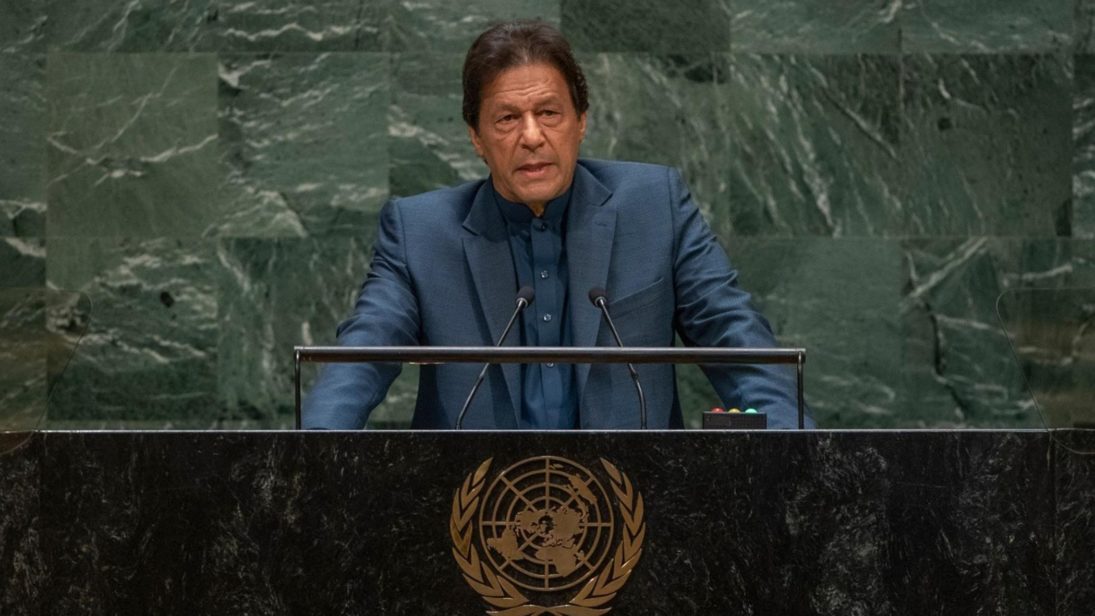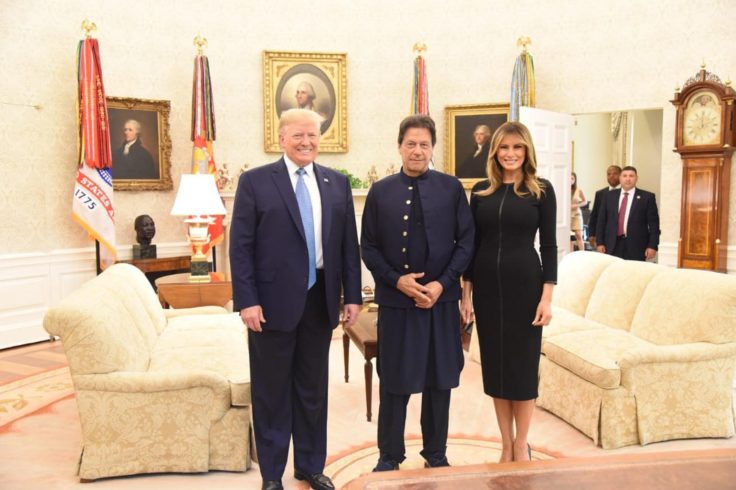
2019 has proven to be an eventful year for Pakistan, from the February Pulwama/Balakot crisis with India to diplomatic battles to avoid blacklisting by the Financial Action Task Force (FATF) in October. The year was marred by internal political and economic challenges, troubled regional security, and shifting global dynamics, all of which had a direct impact on the country. Resurgent tensions with India, bilateral ups and downs with the United States, and a more prominent role in U.S.-Taliban negotiations were just a few of the developments in Pakistan’s 2019 foreign policy. On the domestic front, the country faced an ongoing balance-of-payments crisis, political turmoil, and internal security issues. Although the Imran Khan-led Pakistan Tehreek-e-Insaf (PTI) government has performed comparatively well under a barrage of foreign policy challenges—which show no signs of slowing in the new year—its failure to deliver on domestic promises may be the main threat to the administration in 2020.
Declining Relations with India
2019 was a trying year for India-Pakistan bilateral relations. After taking office in 2018, Prime Minister Imran Khan announced his desire to peacefully engage with India through diplomatic channels. However, his hopes for a peaceful engagement were short lived. In February 2019, the region witnessed a nerve testing challenge following a suicide attack carried out by a young Kashmiri man, Adil Ahmed Dar, and claimed by Pakistan-based Jaish-e-Mohammad (JeM) on an Indian paramilitary force convoy in Pulwama. India’s subsequent airstrikes inside Pakistan further escalated tensions, resulting in cross-border air attacks in Jammu & Kashmir where Pakistan shot down an Indian aircraft and captured the pilot. Although the crisis de-escalated following Pakistan’s return of the pilot, tensions continued to overshadow the bilateral relationship.
Despite bilateral relations hitting a low-point, India and Pakistan kept their pledge to open the Kartarpur corridor. The corridor was officially inaugurated in November 2019 and gives Indian Sikh pilgrims visa-free access to one of Sikhism’s holiest sites: Gurdwara Darbar Sahib in Pakistan.
Aspirations for an improved relationship between India and Pakistan under Narendra Modi’s second tenure virtually died after the Modi administration delivered on one of its campaign promises and revoked Article 370 of the Indian constitution on August 5, which removed the special status of Indian-administrated Kashmir. Although Pakistan’s initial response remained limited to a diplomatic blitzkrieg at global forums—to highlight various human rights abuses by Indian forces in Kashmir—the situation continues with Kashmiris living under curfew and an ongoing internet shutdown, which has crippled business and raised human rights concerns. Continued frustrations in Jammu & Kashmir and statements by Indian leadership on claims to Pakistan-administered Kashmir increase the risk of another crisis between two nuclear-armed states. As Imran Khan warned in his address at the United Nations General Assembly, such a crisis could risk escalating into all-out war.
Despite bilateral relations hitting a low-point, India and Pakistan kept their pledge to open the Kartarpur corridor. The corridor was officially inaugurated in November 2019 and gives Indian Sikh pilgrims visa-free access to one of Sikhism’s holiest sites: Gurdwara Darbar Sahib in Pakistan. The initiative indicated a genuine desire to engage with India on issues of mutual concern. However, its significance as a goodwill gesture and potential to improve bilateral relations was overshadowed by the continued dispute over Kashmir and India and Pakistan still appear poised for continued hostility in 2020.
Pakistan’s Relations with the United States, China, and the World at Large
While relations with India deteriorated, in 2019 Pakistan maintained its traditionally close relations with China and saw a potential warming of relations with the United States. In one of Khan’s most significant trips this year, his maiden visit to the United States in July, indicated a chance at rebuilding U.S.-Pakistan ties. The Khan-Trump bonhomie during the visit marked a shift in deteriorating U.S.-Pakistan relations under the Trump administration. The relationship hit a low-point in 2018 after the Trump administration cut aid to Pakistan, calling on the country to do more to combat terrorism. Improvements in the relationship can be traced to the United States’ need for Pakistan to help facilitate U.S.-Taliban negotiations, which will help U.S. President Trump keep his campaign promise of withdrawing troops from Afghanistan. While cooperation over Afghanistan may be improving stability in U.S.-Pakistan ties, it also reflects the continued transactional nature of the relationship, and the extent to which Trump sees Pakistan through the prism of Afghanistan.
In 2020, the U.S.-Pakistan relationship may be tested by evolving U.S.-China competition, drawing the United States closer to India. U.S. apprehensions over Pakistan’s historically close ties with China were evident in Ambassador and Assistant Secretary Alice Wells’ recent criticism of the China Pakistan Economic Corridor (CPEC). Washington’s perceived tilt towards India as a means of countering China’s influence in the region may continue to frustrate Pakistan. Maintaining the recent bout of good will between the United States and Pakistan will largely depend on how successfully Pakistan remains relevant in the regional dynamics and balances itself between the growing U.S.-China rivalry.

Despite a perceived slowdown of the CPEC projects under the PTI government, Pakistan-China interests converged on several crucial issues in 2019. Since taking office last year, Khan has made three official visits to China, the latest being in October. During the Pulwama/Balakot crisis in February and March, China played a more pronounced role and urged both sides to exercise restraint. Concerns over China’s role in crisis management, however, merits closer scrutiny especially in assessing future escalation dynamics. Following the Pulwama attack, China did end its decade-long opposition of blacklisting JeM leader Masood Azhar; however, this was after reference to Kashmir was removed from the listing. Although this was seen as a diplomatic win for India, later in the year China’s help was instrumental in calling a special consultative meeting of the UN Security Council to discuss the issue of Kashmir after India’s unilateral revocation of Article 370. Recently, China has once again been pushing for a UN meeting on the subject. Besides diplomatic support, China remains a primary defense partner of Pakistan and recently announced it would multiply its support for Pakistan’s defense.
Beyond relations with the United States and China, Pakistan also actively engaged with the Middle East, possibly moving beyond the traditional Iran-Saudi Arabia binary. While Pakistan maintained its historic ties with Saudi Arabia, securing USD $20 billion in investments in early 2019, Khan also showed an interest in playing a mediation role between Iran and Saudi Arabia by taking trips to each country after the alleged Iranian attack on Saudi oil facilities. Recent developments, however, indicate a situation that is more complex and difficult than previously imagined. Pakistan’s last-minute decision to pull out of the Malaysia summit due to Saudi reservations is likely to taint its credibility as a neutral state in Gulf politics as well as the issues concerning the Muslim world.
The risk of being placed on the FATF blacklist was a persistent challenge throughout the year, which required not only domestic structural reforms but persistent diplomatic efforts to gain the international support necessary to keep Pakistan off the blacklist. After introducing several required reforms, and using diplomatic channels to highlight Pakistan’s efforts, the FATF agreed to extend Pakistan’s deadline to February 2020 in its October meeting. However, while Pakistan has gained some allies in its efforts to get off the FATF gray list, this issue will likely drive its 2020 diplomatic relations.
Domestic Challenges
Economically, Pakistan has faced a stunted economic growth due to high inflation and low employment rates. Despite massive borrowing from friendly countries and the bailout package provided by the IMF, Pakistan’s economic outlook remains grim.
On the domestic front, 2019 was a year packed with political and economic challenges, governance issues, and controversies regarding the role of the establishment in Pakistan’s political sphere. Coming to power with the promise of reform and development, Khan’s PTI government was unable to deliver on multiple promises largely due to an inexperienced team and a lack of clear priorities, where the primary focus was confined to proving corruption of political rivals. A disjointed yet fierce opposition has also hindered his party’s ability to deliver and carve a path different from that of its predecessors.
Economically, Pakistan has faced a stunted economic growth due to high inflation and low employment rates. Despite massive borrowing from friendly countries and the bailout package provided by the IMF, Pakistan’s economic outlook remains grim. Contrary to the PTI government’s vision, Pakistan’s GDP growth has fallen to 3.29 percent in 2019 as compared to 5.5 percent in the previous year. If the current trend continues, growth may fall to 2.7 percent according to World Bank estimates. While the government claims to have invested more in long-term structural reforms, the current economic crisis makes it difficult for the government to deliver on its domestic promises, such as improving access to health care and education and providing “10 million jobs and 5 million homes.” Despite the grim economic picture, there have been positive signs for the year ahead. For instance, Moody’s Investor Service has upgraded Pakistan’s credit rating outlook from negative to stable, citing Pakistan’s growth potential.
Domestically, Pakistani politics became increasingly confrontational in 2019. Although the PTI has a good relationship with the military establishment, the opposition parties continued to rattle the political scene with rallies, sit-ins, and demonstration against government policies. However, these demonstrations had limited impact because the establishment favors the PTI government and the opposition parties are riddled with conflicts of interest, which divide them and make them ineffective.
Conclusion
2019 was a tough year for the relatively inexperienced PTI government. Notably, Imran Khan’s comparatively strong performance on the foreign policy front stands in sharp contrast to his handling of domestic affairs, where he has received criticism for failing to deliver on promised reforms. While patterns from 2019, such as hostile relations with India and oscillating relations with the United States, are likely to remain a factor in Pakistan’s foreign policy for the coming year, the PTI’s real opportunity in 2020 will be improving its performance on the domestic front.
Editor’s Note: SAV contributors from across the subcontinent recap the most significant political, economic, and strategic developments in South Asia in 2019 and analyze what opportunities and challenges lie ahead for each country in 2020. Read the full series here.
***
Click here to read this article in Urdu.
Image 1: Government of Pakistan via Twitter
Image 2: Government of Pakistan


